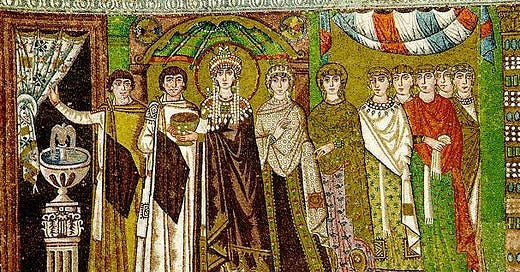
Wedged between the well-recorded 6th century, (think Emperor Justinian and his famous wife Theodora—all fit for TV drama), and the 8th century, (Bede, Beowulf, Charles Martel), the 7th century churned so tumultuously that few people stopped to write it down. Fewer were painting frescos or adhering mosaic tesserae to ceilings.
For the novelist, we are reduced to extrapolation forward and backward in time to make any sense of what our characters might wear, whether farmer, priest, soldier, or matron.
Texts written hundreds of years in either direction use such varied terms for tunics, trousers, cloaks, and sandals, that it is impossible to know what was meant and therefore, what anyone wore in a given century. And yet it is clear, people being people, that variation, styles even, came and went: the right way to pin the cloak or wrap the head, the color and location of the clavi (the ubiquitous woven stripes found on clothing for centuries).1 Are we doing pointed or rounded toes this decade?
We have fewer extant examples. The dry sands of Egypt held some in storage for us, but the early diggers were after golden treasures or more ancient civilizations. They cut through the late Roman (early Byzantine) layers, rarely preserving, less often cataloguing and studying these many hundreds of years of artifacts.
An additional challenge:
By 635 AD, the Romans had been all jumbled up with their northern conquests, Avar invasions, and Persian wars—both victories and defeats. Any male, military or civilian, might wear Central Asian or Persian-style trousers, with an open proto-kaftan, or a long-sleeved, tailored Persian riding coat. A soldier might wield a sword picked up on a battlefield from Londinium to Nineveh.
Style had gone global!
And so, what’s a storyteller to do?
Dream of armies uniformed as red coats vs blue coats.
Be glad I’m not a costume designer.
After hundreds of hours, abandoning definitive answers, I am reconciled to generic terms: cloak, tunic, etc. I’ve gleaned what tidbits of greater interest I can while prioritizing the avoidance of big mistakes.
I spent the last few weeks reviewing military reference material to write my remaining fight scenes. I’m glad I did. I found an oops that would have been off by enough centuries to be embarrassing.
In the end, writing the scenes—moments, really, in many cases, only a few lines—took little time. But that was because of the hours, days, weeks of research. I could finally write these few lines with half an ounce of confidence.
And people wonder why this book has taken years to bring to this point. (The text is currently with my developmental editor! Zoiks!)
The good news is:
Book II is outlined and takes place only four years later. Without fast fashion to contend with, I should NOT have to suffer through all of this again!
As a reader or writer, how important is historical accuracy to you? If “accuracy” can only be loosely applied, how do you approach the problem?
I hope you are all faring well and out of harm’s way. The recent wind/flood damage and loss of life are heartbreaking. I had an opportunity to adjust wind claims for Helene but declined. I’m not certified for FEMA/NFIP’s flood claim handling.
More on that next time.
—Lausanne
If you would like to see clavi for yourself, have a look here: https://fashionhistory.fitnyc.edu/clavus-clavi/





Lausanne, this was fascinating! Thank you for giving us a window into your research process. I'm in the early stages of researching a novel on the year of the Black Death in London (1349), and want my costume/weaponry details, as well as the cultural attitudes and faith of the time, to be faithful to the time. I loved hearing how you're going about it and can't wait to read your book!
Hey Lausanne - Catching up on my reading and wanted to say I really liked this piece. My two cents worth on your question is that historical accuracy is important, but the storyline is more important within a time period. Minute details, for me at least, are not as important as the big historical picture. Readers want the historical narrative to be as accurate as possible, but I don't think most readers dwell too much on whether the clothing worn by the characters is 100% accurate.